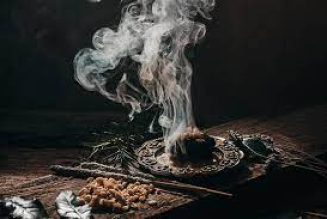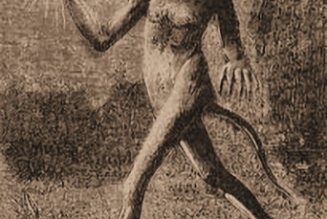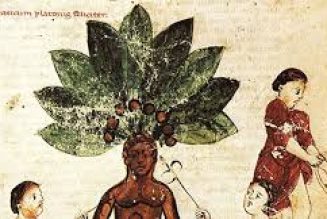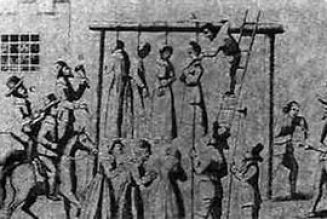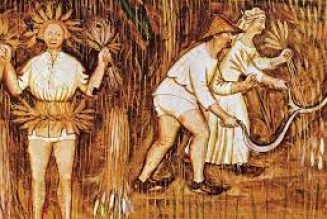
Deep in ancient history, all the way from the regions of eastern Europe and India to the British Isles, are the roots of the worship of Brighid. Her name is also spelled Brigit, Bridget, and Bride (pronounced “breed“). And it means “Fiery Arrow” or “Bright One”. She was always a Fire Goddess and also a Water Goddess. The largest Celtic tribe was called the Brigantes, and their name comes from the same root as the name Brighid. They had Fire Priests. Many place names and names of rivers and streams all over England, Ireland, and Wales have names with the same root as Brighid. She was, and remains, the most powerful and powerfully worshiped Goddess in the British Isles from long, long before the advent of Christianity.
Brighid is of the Tuatha De Danaan, the people of the Great Mother Danu, also called the Fae. She was probably originally a Sun Goddess. The story of Her birth is that She was born at sunrise, and a tower of flame burst forth from the newborn’s forehead reaching from the Earth to the Sun. She is a Fire Goddess.
Brighid is a triple Goddess, but not in the sense many think of as maiden, mother, crone. She has three aspects and all have associations with Fire and Water: Brighid the Healer and Midwife, Brighid the Smith-Craftswoman-Warrior, and Brighid the Inspirer of all arts particularly the written and spoken.
As Brighid the Healer, Her wells and springs figure prominently, as their water is considered holy and healing. She is a Water Goddess. In this aspect She is the teacher of herbal and plant medicine. She is the midwife for birthing women. She is the guardian and caretaker of household domestic animals, particularly cows. She Herself travels with 2 Sacred Oxen, and the white cow, the white swan, and the white wolf are associated with Her as totems. One of the symbols associated with Brighid is the white wand around which a snake is entwined. And this symbol pre-dates Asclepius, the Healer God of the Greeks whose symbol was a serpent coiled around a rod. Brighid tends trees and orchards and the Rowan is sacred to Her. No one in Ireland cuts down a Rowan tree without knowing there will be some misfortune befall him. And the beginning of February is the beginning of the Celtic Tree Month of the Rowan.
Brighid the Smith is mistress of the smithy fire, the anvil. She is associated with horses in this aspect. But this also extends to fine jewelrysmith workings – silver and gold – and any craft that a person might practice and seek to master. She was also then, the creator of swords, daggers, knives, shields and all weapons of protection, as well as cooking vessels and implements. The Hearthfire is sacred to Brighid, and its association with nourishment, food, and health of a family. It was also a place where people gathered together to tell stories, as the oral tradition was sacrosanct to the Celtic peoples.
And that leads to the third aspect of the Goddess, Brighid the Bard, the Inspirer of the Fire in the Heart and Mind, which produces song, music, poetry, stories, writing, eloquence, theatrical performances, and the harp. Although the oral tradition was extremely important to the Celts, and there were people who spent their lives gathering and remembering the stories of their people, Brighid is said to have invented “talking marks,” the Ogham, or writing. And since all of these are associated with the Element of Air, She is also an Air Goddess.
Her center of worship is Kildare, from the Gaelic “Cill Dara” which means Church of the Oak, which illumines a Druid past. This was built on a site which contained a perpetually tended flame. Her Eternal Flame. It was said to be an ashless fire, which indicates that it must have originally been made with tallow, oil, or even butter. Later, as wood was used to keep the flame alive, it was said that the ashes miraculously disappeared. The tradition is that there were 19 priestesses of Brighid, representing the 19 Year Cycle of the Celtic “Great Year”. Each priestess tended the fire in turn through a 20 day rotation. On the 20th day of each rotation, the fire was said to be tended by the Goddess Herself. It burned for centuries and for long after Christianity came to the Isles until in 1220, the Archbishop of Dublin decided that nuns tending the perpetual flame of Brighid, now St. Brigit, was too connected to pagan beliefs and practices and ordered it extinguished. After the death of the Archbishop, the nuns rekindled the ancient flame and it burned again without break until the Reformation around 350 years later, when the entire convent and church was closed. In modern times, several decades ago, The Flame was lit again, and is tended, by nuns.
Brighid is the Goddess associated with Imbolc, the holy days celebrated from the eve on January 31st until the night of February 2nd. It is the beginning of the first signs of Spring’s return. As a Goddess of fertility, household farm animals, plants, trees, She presides over the first buds of plants, the earliest flowers like the snowdrops, and lambs and calves which begin to be born at this time of year. That is why milk, cheese, butter are all set outside on Imbolc Eve to honor her and feed her oxen, as She is said to walk the land on Imbolc Eve.
Brighid’s cross of rushes, which was co-opted by the Church, is thought to have been originally a solar cross or sun wheel indicating the movement of the Sun in the turning of the great Wheel of the Year. People still make these today in the British Isles and Ireland and hang them over the front door for protection, laying the one for the previous year on the hearth fire. Many candles are lit all over the home to encourage and reflect the returning light of the sun, and bonfires are lit outdoors. Strips or squares of cloth are laid outside the door on Imbolc Eve or hung out the ground floor window for Brighid to bless as She passes, and they are brought in the next day to use when healing is needed throughout the year. Fabric bits or strips called clooties are also tied on branches of trees overhanging a Sacred Well or Sacred Spring as prayers to Brighid for healing (this custom happens all year round).
Some of the names referring to the Goddess Brighid are “Mother of All Wisdom”, “Bright One”, “Exalted One”, “Flame of 2 Eternities”, “Ashless Flame”. She is the Flame in the Hearts of All Women! May She bless you with Her mighty strength in this fragile season, in this liminal season as Winter turns to Spring and the earliest flowers of white and green venture forth from the snow seeking the Sun, our hearts greet them with a smile.
